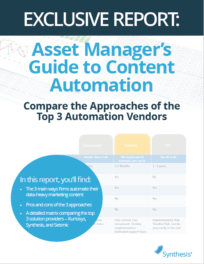Pessimism or Reality? Forbes says Asset Management Marketers are “Still Taking Batting Practice”

An article in Forbes pointed out that asset managers are extremely late in joining the digital marketing movement. This isn’t groundbreaking news, as the industry has long been criticized for the slow adoption of modern marketing practices.
The article points out:
- Financial services was one of the first industries to embrace the digital revolution, just not in marketing. The industry has focused on investing in high-speed connectivity for faster trade execution, as opposed to faster and more successful marketing/sales execution. It’s time to step-up the marketing game.
- Lower Fees and higher competition is driving more creative marketing. Executives are forced to rethink the old model of reaching investors one at a time. It’s an expensive endeavor involving lots of flights, hotels, steak dinners, and conference fees. They must create models for doing this at scale.
- Asset Managers who embrace artificial intelligence and machine learning will increase efficiency. The reduction in operating expenses associated with more efficient marketing will result in decreased cost for the consumer and increased margins for the manager. Asset Managers aren’t adopting digital marketing technologies because they loathe change. Executives who come from an investing background may not see an immediate ROI on this type of investment. Turnkey products do exist, and previously unavailable scale is now built-in.
Even though asset managers are a few steps behind other industries, many are making moves towards digitizing the sales and marketing process. We’ve seen evidence of this over the past couple of years as firms are rethinking their strategies. Firms are being forced to find ways to differentiate themselves and scale their operations in order to survive the fierce competition.
Will Asset Managers Step-up to the Plate in 2018?
Although we still run into firms who are printing and shipping a slew of product-focused marketing collateral, this is now the exception and not the rule. Most firms understand that this is an outdated practice that is time-consuming, error-prone, and expensive. In our annual roundtable meeting in May, most investment marketers said their firms have cut-back significantly on printing and shipping marketing collateral. One investment marketer said, “We’ve started to get away from mass-producing content. The salesforce goes out on their iPads and everything’s done digitally now. There’s very little print delivery anymore.”
Note, however, in a room with ten major asset managers, only one had anything close to concrete plans to invest in this direction. They even spoke of the initiative as being subject to budgets not being cut. This being the state of operations in investment marketing as long as Synthesis has been in this business, marketing and marketing operations are viewed reluctantly as a necessary expense rather than an investment in the firm’s success.
Today, most marketing content is produced and distributed digitally, speeding up time-to-market, minimizing risk, and reducing costs. The money saved on printing and shipping materials is now being reallocated to other marketing activities.
Where are firms are investing to modernize their sales and marketing practices?
Automating Data Processing
Automating data processes is the best way to improve velocity in the marketing and sales process. As soon as the data is available, it can be leveraged in a multitude of ways. The best way to improve the quality and relevance of marketing and client communications is to present meaningful data to the audience in every interaction. For example, one of our clients is building hypothetical portfolio models on the fly in client meetings to illustrate potential outcomes. Data visualizations are very powerful when personalized.
The biggest challenge in realizing automated data processing goals is the unevenness between firms in the ability to produce or consume data in reliable digital formats. The industry as a whole needs to approach data availability and sharing as a critical part of their future success. Oddly we see surprisingly large data quality and availability problems even from the largest data vendors in the industry.
Scaling the Sales Process
The Forbes article points out that executives are forced to “rethink the old model of reaching investors”. Sales enablement technology centralizes the marketing content and then gives it to sales. A good system allows for all kinds of media. It also provides reporting on how often content is being used. To scale the sales process effectively, firms must understand what content resonates and be able to provide that content on-demand. Salespeople need to be able to personalize the presentation quickly for any kind of meeting. When integrated with the CRM and compliance systems, this can further streamline the process and allow salespeople to have more meetings. Ultimately, this should help increase the opportunities in the pipeline, improve close rate, and shorten the average sales cycle.
Integrating Sales, Marketing, and Compliance Systems to Close Inefficient “Gaps”
Implementing technology to create efficiency is a good thing. But, there is the issue of there being “too much of a good thing”. Sometimes there are gaps in the individual systems that require manual steps or workarounds to complete the entire process. For example, one of our clients is using our platform to automate their marketing collateral (fact sheets, commentaries, etc.) Then, they were manually downloading these files from our system and uploading them into their compliance system for record-keeping. By integrating the two technologies, they’ve eliminated these cumbersome and time-consuming manual steps to dramatically improve efficiency and risk management.
So, while asset managers have been slow to change, I agree with the author that 2018 will be the year that many firms step out of the proverbial batting cage and onto the field to play ball.
How Can Executives Be Convinced?
Our Head of Marketing posted the Forbes article on LinkedIn last week, and one person commented that the state of investment marketing is “[F]ar, far worse than the Forbes reporter makes it appear. These people still play golf in white shoes and write with quill and ink-stained cuffs. Their marketing practices are primitive, directed by non-marketers and frankly stupid in their conceptualizations and assumptions of what their customers want to hear. They are a very long way before the advantages of AI will have any effect at all, perhaps a generation of dead generals who need to get out of the way.”
I’m not sure if I’d call this comment pessimistic or ‘sad but true’ — but it’s probably a little of both. I’ve definitely seen my fair share of executives who are hard-pressed to change. However, I’ve also seen some very forward-thinking executives make smart investments and lead their team to victory. For marketers who are having a tough time getting buy-in, we usually recommend doing an ROI analysis. The key to convincing executives to invest in automation is showing the potential ROI when implementing a system.
Download our Guide to Illustrating ROI on Content Automation for some ideas on how to do this, or contact us and we’d be happy to give you some advice based on your specific situation and goals.
Here are some related resources that might interest you: From the Blog: 3 Factors that Complicate Factsheet Automation |  From the Blog: How much does it cost to automate factsheets? 🧐 |  From the Blog: What is your ROI on producing marketing content? |




 Compare the Top 3 Finserv Content Automation Vendors [White paper]
Compare the Top 3 Finserv Content Automation Vendors [White paper] Create Pitchbooks the Drive Sales [White paper]
Create Pitchbooks the Drive Sales [White paper] Build vs. Buy: Should Your Financial Services Firm Outsource or Insource Marketing Technology? [White paper]
Build vs. Buy: Should Your Financial Services Firm Outsource or Insource Marketing Technology? [White paper]  10 Tips for Rebranding your Fund Marketing Documents [White paper]
10 Tips for Rebranding your Fund Marketing Documents [White paper]




